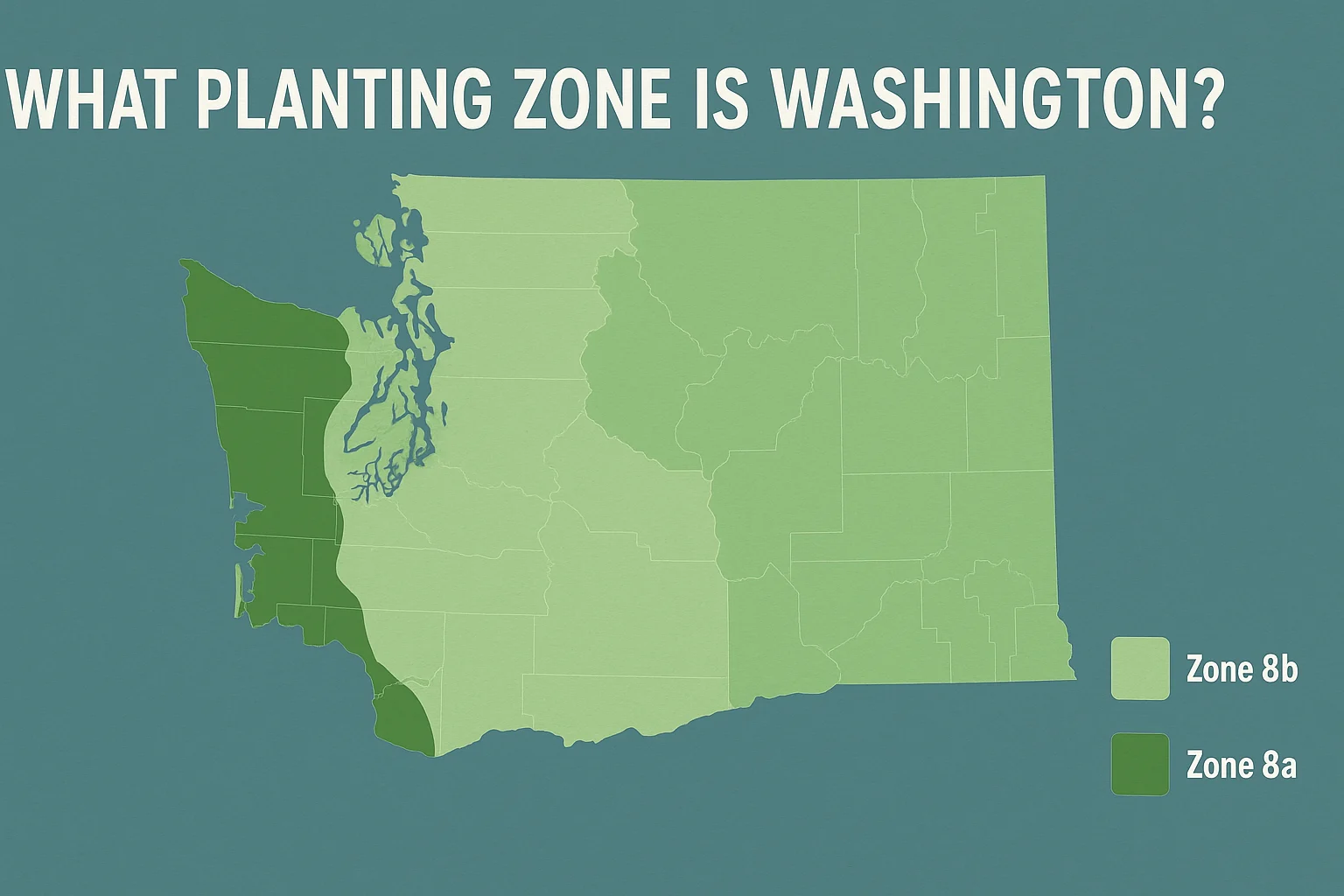What Planting Zone is Washington?[Map, Cities, and Growing Tips]

What Planting Zone is Washington? Washington’s planting zones range from 4a to 9a, covering a wide spectrum of climates. The majority of Washington falls within planting zones 6a, 6b, 7a, and 8a. Eastern Washington includes zones 4a, 5a, and 6a, while the western coastal regions are primarily in zones 8a and 8b. This diversity makes understanding the planting zone in Washington essential for gardeners and landscapers alike.
In this guide, you’ll discover which planting zone Washington falls into, how it affects plant choices, and practical tips for growing in this diverse state.
🌿 What Planting Zone is Washington?
The planting zone Washington belongs to depends largely on geography:
| Region | USDA Planting Zone |
|---|---|
| Eastern Washington (Spokane, Pullman) | Zones 4a – 6a |
| Central Washington (Yakima, Wenatchee) | Zones 5b – 7a |
| Western Washington (Seattle, Tacoma, Olympia) | Zones 8a – 8b |
| Pacific Coast (Aberdeen, Forks) | Zone 9a |
- Eastern Washington: Colder winters, zones 4a to 6a.
- Western Washington: Milder winters, zones 8a to 9a.
- Mountainous areas (Cascades, Olympics): Can dip into zone 4b due to elevation.
Understanding your planting zone Washington is critical for selecting perennials, trees, and even annuals suited to your microclimate.
🏡 Planting Zones in Major Washington Cities
| City | USDA Planting Zone |
|---|---|
| Seattle | Zone 8b |
| Spokane | Zone 6a |
| Tacoma | Zone 8a |
| Olympia | Zone 8a |
| Bellingham | Zone 8b |
| Yakima | Zone 6b |
| Wenatchee | Zone 7a |
| Vancouver, WA | Zone 8b |
| Pullman | Zone 6a |
While these zones provide a general guideline, local microclimates, wind exposure, and urban heat effects can shift conditions slightly.
🌡️ Why Planting Zone Matters in Washington?
If you’re planting lavender in Spokane or palm trees near Seattle, knowing your planting zone Washington ensures your plants survive the winter.
- Eastern Washington: Needs cold-hardy varieties (e.g., Zone 5+).
- Western Washington: Supports more tender perennials, due to maritime influence.
- Coastal Washington: Zone 9a areas can accommodate some subtropical species.
Your Washington planting zone directly impacts:
- Frost tolerance
- Plant survival through winter
- Timing of sowing and harvesting
- Pest and disease pressure
🧠 Real-World Example: Tomatoes in Washington
- Spokane (Zone 6a): Plant tomatoes after the last frost, around late May.
- Seattle (Zone 8b): Can start as early as late April, giving you a longer harvest window.
Zones affect both what you can plant and how long you can enjoy the fruits of your labor.
📅 Planting Calendar for Washington by Zone
| Crop Type | Zone 6 Start | Zone 7 Start | Zone 8 Start | Zone 9 Start |
|---|---|---|---|---|
| Cool-weather veggies | March–April | February–March | January–February | December–January |
| Warm-weather crops | May–June | April–May | March–April | February–March |
| Perennials | Early spring or fall | Same | Same | Fall preferred |
🌧️ Gardening Tips for Washington’s Climate
- Western Washington: Focus on moisture-loving plants; ensure excellent drainage to combat soggy soils.
- Eastern Washington: Drought-resistant plants and efficient irrigation are key.
- Windbreaks: Use hedges or structures to protect sensitive plants in exposed areas.
- Mulch liberally: Helps regulate soil temperature and retain moisture statewide.
For maximum success, always align your plant selection with your specific planting zone Washington location.
🌎 Find Your Exact Washington Planting Zone
For hyper-local accuracy, use the USDA Plant Hardiness Zone Map. Simply enter your zip code to confirm your planting zone in Washington.
🧮 Recommended Tools for Washington Gardeners
- Soil Volume Calculator – Know exactly how much soil you need for raised beds.
- Plant Spacing Calculator – Prevent overcrowding and maximize yield.
- Indoor Plant Watering Calculator – Perfect for your houseplants or container garden.
🙋 Frequently Asked Questions
What is the most common planting zone in Washington?
The majority of Western Washington falls in planting zones 8a and 8b, making it the most common range across the state.
Can you grow citrus in Washington?
Citrus trees require at least Zone 9a for outdoor survival. While some parts of coastal Washington reach Zone 9a, most gardeners opt to grow citrus in containers and bring them indoors over winter.
When is the last frost in Washington?
- Zone 6a (Spokane): Late May
- Zone 7a (Wenatchee): Mid to late April
- Zone 8b (Seattle, Tacoma): Late March to early April
✅ Final Thoughts: Planting Zone Washington Guide
Understanding the planting zone Washington belongs to isn’t just technical trivia — it’s the foundation of successful gardening. Whether you’re facing Spokane’s frosty winters or Seattle’s wet springs, knowing your USDA zone lets you plan better, plant smarter, and grow happier.
Match your plants to your zone, and you’ll spend less time worrying about survival and more time enjoying blooms, veggies, and lush greenery.
